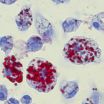(Press-News.org) In what could be a breakthrough in the treatment of deadly brain tumors, a team of researchers from Barrow Neurological Institute and Arizona State University has discovered that the immune system reacts differently to different types of brain tissue, shedding light on why cancerous brain tumors are so difficult to treat.
The large, two-part study, led by Barrow research fellow Sergiy Kushchayev, MD under the guidance of Dr. Mark Preul, Director of Neurosurgery Research, was published in the Sept. 14 issue of Cancer Management and Research. (Monocyte galactose/N-acetylgalactosamine-specific C-type lectin receptor stimulant immunotherapy of an experimental glioma.) The study explores the effects of immunotherapy on malignant gliomas, cancerous brain tumors that typically have a poor prognosis.
What the researchers discovered was that immune cells of the brain and of the blood exhibit massive rearrangements when interacting with a malignant glioma under treatment. Essentially, the study demonstrates that the complex immune system reacts differently in different brain tissues and different regions of the brain, including tumors.
"This is the first time that researchers have conducted a regional tissue study of the brain and a malignant glioma to show that these immune cells do not aggregate or behave in the same way in their respective areas of the brain," says Dr. Preul. "This means that effective treatment in one area of the brain may not be effective in another area. In fact, it could even cause other regions of the tumor to become worse."
The results of the study provide important insight into why clinical trials involving immunotherapies on glioma patients may not be working.
### Drs. Kushchayev and Preul's research team included Barrow's Dr. Adrienne Scheck, Dr. Fu-Dong Shi and Dr. Jenny Eschbacher; Arizona State University scientists Dr. Ken Hoober and Dr. Laura Eggink; and several research fellows. The three-year study was primarily funded by the Arizona Biomedical Research Commission.
Barrow researchers make breakthrough on immune system and brain tumors
2012-09-27
ELSE PRESS RELEASES FROM THIS DATE:
Sandia shows why common explosive sometimes fails
2012-09-27
ALBUQUERQUE, N.M. — The explosive PETN has been around for a century and is used by everyone from miners to the military, but it took new research by Sandia National Laboratories to begin to discover key mechanisms behind what causes it to fail at small scales.
"Despite the fact explosives are in widespread use, there's still a lot to learn about how detonation begins and what properties of the explosive define the key detonation phenomena," said Alex Tappan of Sandia's Explosives Technology Group.
Explosives are typically studied by pressing powders into pellets; tests ...
Scientists find way to control sugars
2012-09-27
A study co-led by Simon Fraser University and Purdue University has found that the intestinal enzymes responsible for processing starchy foods can be turned on and off, helping to better control those processes in people with Type 2 diabetes.
The process, called "toggling," was discovered in the lab of SFU V-P Research and chemist Mario Pinto, who has designed inhibitors capable of regulating each of the four starch-digesting enzymes known as alpha-glucosidases. It could lead to several solutions for diabetics and those prone to obesity.
Three of these enzymes are responsible ...
Contributions of deaf people to entomology: A hidden legacy
2012-09-27
Communication of discoveries has always been a hallmark of science, yet the challenges of making significant contributions to entomology did not stop many deaf and hard of hearing people as the field grew in the late 19th and early 20th centuries. Written by the Harry G. Lang (Professor Emeritus, National Technical Institute for the Deaf, Rochester Institute of Technology, Rochester, NY), a deaf scholar, and by entomologist Jorge A. Santiago-Blay (National Museum of Natural History, Smithsonian Institution, Washington, DC), this review paper reveals the fascinating stories ...
AgriLife Research expert: Salt cedar beetle damage widespread after warm summer
2012-09-27
AMARILLO – Salt cedar along the waterways of the southern and eastern Panhandle is rapidly being defoliated and dying back, and one Texas A&M AgriLife Research entomologist believes he knows why.
When salt cedar beetles from Uzbekistan were released in 2006 by Dr. Jerry Michels and his entomology crew in parts of Lake Meredith and the Palo Duro Canyon, it was thought they would be more prolific eaters of salt cedar than other beetle species tried before.
Salt cedar displaces native vegetation and impacts the availability of water, Michels said. Numerous projects have ...
Antipsychotic drugmakers target marketing dollars at DC Medicaid psychiatrists
2012-09-27
Washington, D.C.–The D.C. Department of Health (DOH) has released a study by George Washington University School of Public Health & Health Services (SPHHS) indicating the high levels of marketing by antipsychotic drug manufacturers to Medicaid psychiatrists in the District of Columbia.
Antipsychotics are one of the top-selling drug classes; In 2010, top antipsychotic manufacturers spent more than $25 million on marketing in Washington DC. Among 26 psychiatrists receiving at least $1000 from top antipsychotic manufacturers in 2010, 7 (27%) were Medicaid providers. Medicaid ...
Study adds to efforts to find more effective anti-inflammatory drugs
2012-09-27
CINCINNATI – Researchers have discovered a previously unknown function for a protein that could add to the expanding arsenal of potential new drugs for battling inflammation and tissue fibrosis in a number of disease processes.
Scientists from Cincinnati Children's Hospital Medical Center report Sept. 27 in Developmental Cell that, a protein called TRPC6 mediates a molecular pathway critical to the body's repair processes following various forms of injury caused by disease.
After injury – such as that caused by a heart attack – the TRPC6-controlled pathway prompts ...
Social bullying prevalent in children's television
2012-09-27
Washington, DC (September 24, 2012) – Children ages 2-11 view an alarming amount of television shows that contain forms of social bullying or social aggression. Physical aggression in television for children is greatly documented, but this is the first in-depth analysis on children's exposure to behaviors like cruel gossiping and manipulation of friendship.
Nicole Martins, Indiana University, and Barbara J. Wilson, University of Illinois, Urbana-Champaign, published in the Journal of Communication a content analysis of the 50 most popular children's shows according to ...
New way of fighting high cholesterol upends assumptions
2012-09-27
Atherosclerosis – the hardening of arteries that is a primary cause of cardiovascular disease and death – has long been presumed to be the fateful consequence of complicated interactions between overabundant cholesterol and resulting inflammation in the heart and blood vessels.
However, researchers at the University of California, San Diego School of Medicine, with colleagues at institutions across the country, say the relationship is not exactly what it appears, and that a precursor to cholesterol actually suppresses inflammatory response genes. This precursor molecule ...
Mayo Clinic finds way to weed out problem stem cells, making therapy safer
2012-09-27
ROCHESTER, Minn. -- Mayo Clinic researchers have found a way to detect and eliminate potentially troublemaking stem cells to make stem cell therapy safer. Induced Pluripotent Stem cells, also known as iPS cells, are bioengineered from adult tissues to have properties of embryonic stem cells, which have the unlimited capacity to differentiate and grow into any desired types of cells, such as skin, brain, lung and heart cells. However, during the differentiation process, some residual pluripotent or embryonic-like cells may remain and cause them to grow into tumors.
"Pluripotent ...
Scientists find molecular link to obesity and insulin resistance in mice
2012-09-27
BOSTON--Flipping a newly discovered molecular switch in white fat cells enabled mice to eat a high-calorie diet without becoming obese or developing the inflammation that causes insulin resistance, report scientists from Dana-Farber Cancer Institute.
The researchers say the results, to be published in the Sept. 28 issue of the journal Cell, provide the first known molecular link between thermogenesis (burning calories to produce heat) and the development of inflammation in fat cells.
These two processes had been previously thought to be controlled separately. Thermogenesis ...



